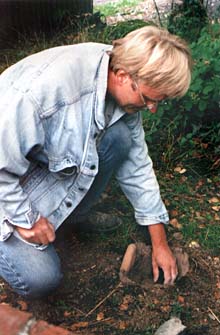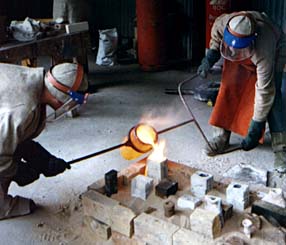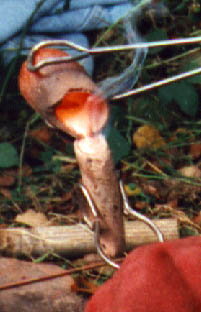|
POURING THE BRONZE AGE In August '99 Rosemary Canavan took part in the fourth Umha Aois , an experimental bronze casting symposium to celebrate the art, culture and technology of the Bronze Age 'You should have left the bricks behind!' The kindly man who heaved my bag up onto the Bangor bus was astonished at its weight. Not that there were any bricks inside it - a lump hammer, a collection of chisels and a huge array of other tools were causing the problem. I was on my way to the Ulster Folk Museum, to join twenty other artists who had come together to investigate ancient techniques of bronze casting and to make work inspired by the culture and technology of the Bronze Age. Inside the museum I was rescued by George and driven to Corradreenan Farm, where preparations for the symposium were in full swing. Tina was lining a wire cage with thick refractory wadding to make a kiln. A home-made furnace, of welded steel and wadding with a propane torch underneath, was already in place. But we were not here for the modern technology, although it was useful. We hoped to cast in stone and baked-clay moulds, and by exploring the past find ways we could use the small-scale technology for experimentation in our own work. Technically we were a mixture of novices and experts, who all shared a passionate interest in the Bronze Age. And we were still waiting for the star of the show, Anders the Swedish archeologist, who had successfully constructed a pit furnace using information from Viking metal-working sites, and was still somewhere between Stockholm and Aldergrove airport. As artists arrived from the various extremities of Ireland we helped where we could, then left to eat, and to check out the nightlife of Hollywood, Co. Down. On our return, much later, we found a lonely figure with a shock of blonde hair sitting under a street lamp on the steps of a reconstructed village hall. Anders had made it at last. The next day, I walked to the farm through the rather surreal 'virtual country' of the Folk Museum. We shared our working area with chickens and a couple of enormous sows. Today there was more livestock: a donkey at one end of the barn, and the horse who pulled a trap for visitors at the other. The donkey registered his disapproval of the proceedings with a series of ear-splitting brays, while the horse liberally provided us with an important Bronze Age ingredient for moulds - manure. The first day we made cuttle-fish moulds, rubbing their underbellies together to flatten them, then scooping out shapes. Its easy and doesn't use much bronze, and you get an interesting ribbed effect from the texture of the cuttlefish. As we worked a gentle roaring announced the lighting of the furnace, a sound that was to become our constant companion. By this time our cuttlefish moulds were set in sand ready for the first pour. Niall, Padraig and Dave donned leathers and visors, the roar of the furnace suddenly stopped, and we fell silent and gathered around to watch. Niall reached into the furnace with tongs and gripped the red-hot crucible, then set it in the waiting shank. The other two lifted this with infinite care, steadying it for skimming, then tipping it towards the first of the moulds. There was a satisfying snort and a spurt of flame as the cuttlefish filled with orange liquid, which dulled to ruby, then crusty black. As the pouring finished we clapped, exhilarated and relieved. Meanwhile Anders had been working furiously at his own fire and was ready to pour. Grasping the little crucible with one pair of cooking tongs and his mould with another, he managed a perfect pour, to another burst of applause. This was the first successful operation of a pit furnace during a symposium; the year before, with an overestimation of the ratio of fire to bronze, the furnace had tended to roast the sculptors as well as the metal.
Next day the others continued with pattern-making. Tempted by the soft white stone that was stacked in a corner of the barn, I asked if I could carve a stone mould, and Padraig prepared two blocks for me. I'd never carved stone before, and loved it. It was easy to work, and I cut a long curving shape based on a willow leaf I had picked in the park. A leaf arrow: a weapon to help Nature fight back.
In the barn everyone was furiously busy. Dave showed us how to make a three-piece clay mould, using a core to make the socketed axeheads of the later Bronze Age. Later he gave a quick demonstration of woodcarving, shaping a delicate bronze age chisel. Patrick, who was casting from twigs, manfully insisted on using the traditional bronze age recipe of manure and clay for his moulds - the rest of us let ourselves be reassured by Anders' insistence that sawdust worked just as well as a mixer. The pace quickened as the week went on. Tina pounded clay and baked moulds, and we filled them before they cooled. We each took a turn - nervously - to put on the leathers and pour from the big crucible. Once we were still pouring after dark, our faces bathed in red light as the hot metal streamed into the moulds. Visitors passed, but we were a tribe apart, priests of a fire god whose roar accompanied all our work. Near the end came our trip to Belfast. After visiting a foundry in Millfield Tech, and checking out the Ormeau Baths Gallery, we went on to the Ulster Museum for a talk by Dr Warner, head of the Archeology department. He had promised to let us handle some bronze age pieces. 'Of course the Irish aren't Celts,' he began. A perceptable shock went round the table. The Celts, he explained, like the Normans, came as conquerers rather than immigrants, ruling over a population which retained their Bronze Age ancestry. So most of us were Tuatha Dé Danann rather than the Sons of Míl. Reverently we touched a bronze spearhead of exquisite proportion, a rapier that had been offered to the river god before the maker had finished tempering it, an axe patinated with the beautiful olive verdigris of extreme age, a curving trumpet. Finally we strolled back to the city centre, and packed a snug under the ornate swirls of the Crown Liquor Saloon, where the locals welcomed the crowd of unruly Southern artists with remarkable calmness. I left with a determination to continue experimenting, and a series of images: Padraig wielding a hammer to smash an ingot as mightily as Thor or Goibhniu, Anders working at the pit furnace with smut-blackened face under his blonde thatch, the quiet of the Ulster country as I walked to work past old gates between their round-capped stone pillars. And of course there was the eclipse. We had talked of pouring bronze
while it was on, of joining hands in crazy rituals. But in the event
we, like the rest of Nature, simply stopped what we were doing and gazed
with wonder. 'You're not meant to look at it!' Lorraine kept insisting,
afraid we would all go home blind. But the sky was speckled with clouds
which dimmed the glare, and through them we watched the sun turn to
a glowing moon, turn upside down, then gradually wax again. The hens,
who normally cackled all day like old women savouring a particularly
wicked piece of gossip, fell utterly silent. Some tucked their heads
under their wings and slept, enchanted as the fowl of Sleeping Beauty's
castle. And then the eclipse passed its peak, the world we knew gradually
began to return, and the cock suddenly lifted his head and crowed. The Umha Aois Organizing Committee would like to acknowledge (and thank!) all the participants, technicians and facilitators: Rosemary Canavan, Joanne Hatty, Martha Quinn, Sandy Sexton, Maeve McKeogh, Christine Mackey, Fiona Ginnell, Kevin J. O'Dwyer, Patrick Ward, Lorraine Whelan, Annie Hendrichsen, David Kinane, Anders Söderberg, Tina Byrne, Pádraig McGoran, Cliodna Cussen, Dympna Molloy, Niall O'Neill, and James Hayes. We would also like to thank our sponsors: The Ulster Folk & Transport Museum, The Arts Council of Northern Ireland, BOC Gases, Bronze Art Ltd., Cast Ltd., Coldec, P.J. Dix, Isaac Mullen Ltd., Fordham Thermal Systems, James Murphy & Son, RPM, Scarva Pottery Supplies Ltd., Silica Sand Co., and Weldtech. |
|||||||
|
 Anders,
meanwhile, was busy under a tree just beyond the barn, lining a small
pit with clay for his fire. He had reconstructed a double bellows from
a Viking rock drawing, and had brought little crucibles with curved
bases. He showed us how to make these, waxing the end of a sturdy stick
and shaping clay over it. Heat the wax, and the crucible slips off ready
for firing.
Anders,
meanwhile, was busy under a tree just beyond the barn, lining a small
pit with clay for his fire. He had reconstructed a double bellows from
a Viking rock drawing, and had brought little crucibles with curved
bases. He showed us how to make these, waxing the end of a sturdy stick
and shaping clay over it. Heat the wax, and the crucible slips off ready
for firing. On
the second day we carved plaster patterns for clay moulds. I was pleased
with my two bronze axes, even though their historical accuracy was dubious.
I had only seen photographs of the originals, but a visit to the bronzes
in the Ulster Museum was promised at the end of the week.
On
the second day we carved plaster patterns for clay moulds. I was pleased
with my two bronze axes, even though their historical accuracy was dubious.
I had only seen photographs of the originals, but a visit to the bronzes
in the Ulster Museum was promised at the end of the week. When
it was ready I was warned that the stone might split. At the previous
symposium none of the stone moulds had survived the blast of heat from
the molten metal. I decided to pour in the pit fire, with my mould heating
in a smaller fire while the bronze was melting. Using the pit furnace
was very hard work. Either the Vikings were much more patient than us
or else they had some secrets we still hadn't discovered. Feeding the
glowing area around the crucible continuously with tiny pieces of peat
and charcoal, my face became baked and charcoal-smeared, while a succession
of helpers kept up a frenzied pumping on the bellows. After an hour
the bronze was runny, and beginning to silver. Clearing away the charcoal,
I tried to grip the crucible with the tongs. It wasn't so easy. On my
first two attempts the crucible slipped away - I was terrified it would
spill - and the heat was so intense that I could feel my fingers beginning
to burn through the glove. But it was now or give up. On the third attempt
I managed to grip the crucible, and then pouring the metal into the
little cup on the top of the mould was easy. 'Better leave it to cool
down' I was advised, and so I went to eat. That evening everybody crowded
round as I began to open it. The wires were snipped, the stone parted,
and there, like a miracle, lay my little golden arrow, edged around
with incredible, wriggling rays where slivers of metal had escaped between
the stones. And both parts of the mould were still perfect. I decided
to cast some more, and keep the rays.
When
it was ready I was warned that the stone might split. At the previous
symposium none of the stone moulds had survived the blast of heat from
the molten metal. I decided to pour in the pit fire, with my mould heating
in a smaller fire while the bronze was melting. Using the pit furnace
was very hard work. Either the Vikings were much more patient than us
or else they had some secrets we still hadn't discovered. Feeding the
glowing area around the crucible continuously with tiny pieces of peat
and charcoal, my face became baked and charcoal-smeared, while a succession
of helpers kept up a frenzied pumping on the bellows. After an hour
the bronze was runny, and beginning to silver. Clearing away the charcoal,
I tried to grip the crucible with the tongs. It wasn't so easy. On my
first two attempts the crucible slipped away - I was terrified it would
spill - and the heat was so intense that I could feel my fingers beginning
to burn through the glove. But it was now or give up. On the third attempt
I managed to grip the crucible, and then pouring the metal into the
little cup on the top of the mould was easy. 'Better leave it to cool
down' I was advised, and so I went to eat. That evening everybody crowded
round as I began to open it. The wires were snipped, the stone parted,
and there, like a miracle, lay my little golden arrow, edged around
with incredible, wriggling rays where slivers of metal had escaped between
the stones. And both parts of the mould were still perfect. I decided
to cast some more, and keep the rays.